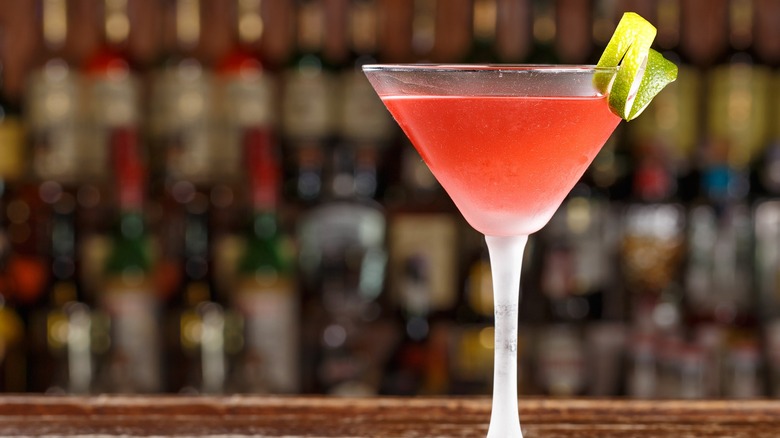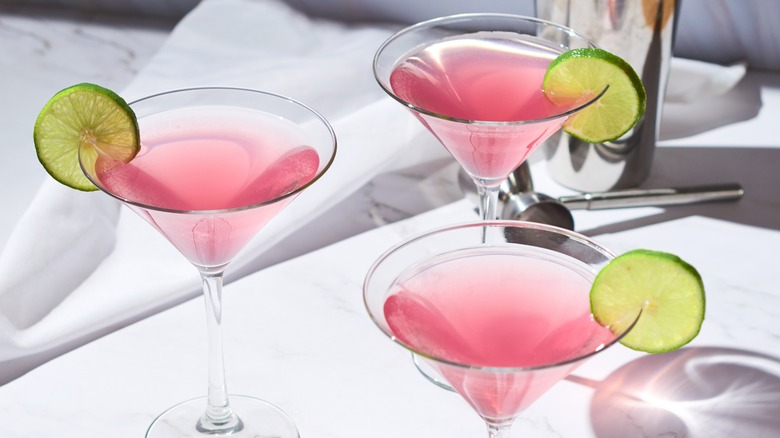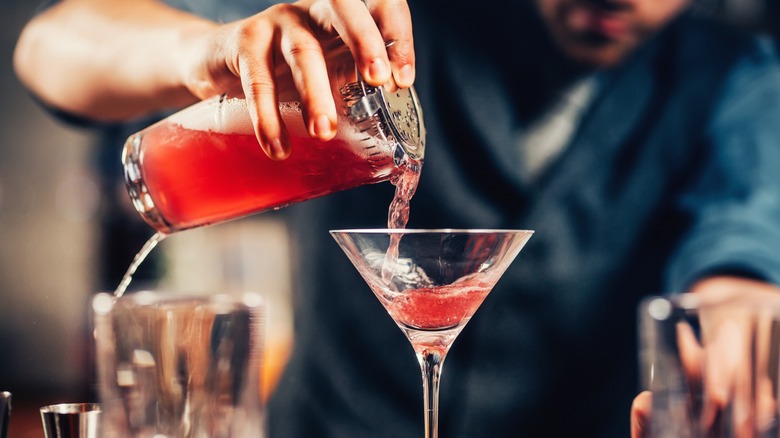The Long-Debated Origins Of The Cosmopolitan Cocktail
While you may not see it ordered as often anymore, the Cosmopolitan cocktail was one of the hottest drinks of the late '90s and early aughts thanks in no small part to the popular HBO show "Sex and the City" highlighting the drink. Iconically pink, subtly sweet, and perfectly tart, the Cosmopolitan has earned its reputation as a classic cocktail. Not to be confused with the Metropolitan, the version that we know and love today was born in the '80s — but the history of the Cosmopolitan goes back much farther than that.
One of the most interesting things about the Cosmopolitan is just how hotly debated its origin story is. If there's anything to glean from the conversation it's that no one really knows who to give credit to. It's quite likely that the drink spontaneously arose in multiple locations around the same time, independent of each other. History is full of these so-called multiple discoveries, such as the telephone being credited to Alexander Graham Bell while a patent for the same invention was submitted independently by Elisha Gray on the same day.
There are other examples, though you won't normally find cocktail inventions on that list. The Cosmopolitan is generally considered to be an evolution of the Kamikaze cocktail. The Kamikaze uses 2 ounces of vodka for its base with ¾ ounce Cointreau and ¾ ounce lime juice as its co-conspirators. The modern Cosmopolitan uses 1 1⁄2 ounces of Citron vodka, ¾ ounce of Cointreau, ¾ ounce of lime juice, and ½ ounce of cranberry juice.
The Cosmopolitan's history on the rocks
Although they were different drinks altogether, there are several recipes for Cosmopolitan cocktails dating back to the '30s and '40s – some of which shared the modern version's pinkish hue. Others were closer to a Long Island Iced Tea with six different ingredients including scotch, vodka, and vermouth. They shared the same name, but not always the same spirit. Fast forward to the 1970s and you have something of a proto-Cosmopolitan circling its way through the thriving U.S. LGBTQ+ bar scene. The drink was made of vodka, grenadine, and lime juice and had the "pretty in pink" aesthetic that the Cosmopolitan would come to be known for. We'll come back to this in a second.
The first person to lay claim to the Cosmopolitan is Neal Murray, who, in Minnesota in 1975, gave a touch of color to a Kamikaze by adding cranberry juice. If true, this would have indeed been the first Cosmopolitan. Murray had only been a bartender for a few months at the time, so he didn't exactly have the reputation necessary to catapult his concoction to stardom. But he started teaching the Cosmopolitan to other bartenders in San Francisco in 1981.
Absolut Citron vodka wasn't released until 1988, so Murray's version wasn't the true form we see today. Cheryl Cook was bartending in Miami at the time, and in 1988, she used the Citron as a base to which she added triple sec (read, Cointreau), lime juice, and a splash of cranberry — which sounds a lot like a modern Cosmopolitan to us.
The one true king?
While both of these stories throw wrenches in the machine, credit for inventing the Cosmopolitan is usually given to one Toby Cecchini, who was bartending in Manhattan when he's said to have invented the Cosmopolitan, also in 1988. The proto-Cosmopolitan made with grenadine that was popular in San Francisco was introduced to him through Melissa Huffsmith, a coworker who had previously worked with bartender Patrick Mitten — the one credited with introducing the Cosmopolitan to New York via San Francisco.
Cecchini thought the drink was too sweet (which it likely was) and decided to make it closer to a margarita served up so he used Citron vodka, Cointreau, lime juice, and cranberry juice to create the Cosmopolitan that we know and love today. The drink would go on to ride the flavored martini craze that swept through the '90s as the undisputed champion. It's hard to imagine just how popular this drink became, especially since the '90s cocktail renaissance wouldn't spark until the turn of the millennium.
Whether you feel Neal Murray and Cheryl Cook were cheated of glory or you think Cecchini has the rightful claim, the story of the Cosmopolitan is an excellent illustration of the messy and often capricious nature of cocktails. Somewhere in the world, some new bartender is mixing ingredients together that will become a classic after the right bartender working at the right bar at the right time happens upon it years later. While the fame is fun, in the end, what matters is that the drink is deviously delicious – a legend through and through.


